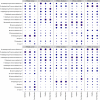Preprocessing significantly improves the peptide/protein identification sensitivity of high-resolution isobarically labeled tandem mass spectrometry data
- PMID: 25435543
- PMCID: PMC4350035
- DOI: 10.1074/mcp.O114.041376
Preprocessing significantly improves the peptide/protein identification sensitivity of high-resolution isobarically labeled tandem mass spectrometry data
Abstract
Isobaric labeling techniques coupled with high-resolution mass spectrometry have been widely employed in proteomic workflows requiring relative quantification. For each high-resolution tandem mass spectrum (MS/MS), isobaric labeling techniques can be used not only to quantify the peptide from different samples by reporter ions, but also to identify the peptide it is derived from. Because the ions related to isobaric labeling may act as noise in database searching, the MS/MS spectrum should be preprocessed before peptide or protein identification. In this article, we demonstrate that there are a lot of high-frequency, high-abundance isobaric related ions in the MS/MS spectrum, and removing isobaric related ions combined with deisotoping and deconvolution in MS/MS preprocessing procedures significantly improves the peptide/protein identification sensitivity. The user-friendly software package TurboRaw2MGF (v2.0) has been implemented for converting raw TIC data files to mascot generic format files and can be downloaded for free from https://github.com/shengqh/RCPA.Tools/releases as part of the software suite ProteomicsTools. The data have been deposited to the ProteomeXchange with identifier PXD000994.
© 2015 by The American Society for Biochemistry and Molecular Biology, Inc.
Figures




Similar articles
-
pClean: An Algorithm To Preprocess High-Resolution Tandem Mass Spectra for Database Searching.J Proteome Res. 2019 Sep 6;18(9):3235-3244. doi: 10.1021/acs.jproteome.9b00141. Epub 2019 Aug 14. J Proteome Res. 2019. PMID: 31364357
-
MS2-Deisotoper: A Tool for Deisotoping High-Resolution MS/MS Spectra in Normal and Heavy Isotope-Labelled Samples.Proteomics. 2019 Sep;19(17):e1800444. doi: 10.1002/pmic.201800444. Epub 2019 Aug 8. Proteomics. 2019. PMID: 31328383
-
Quantitative proteome analysis using isobaric peptide termini labeling (IPTL).Methods Mol Biol. 2011;753:65-76. doi: 10.1007/978-1-61779-148-2_5. Methods Mol Biol. 2011. PMID: 21604116
-
Trends in the Design of New Isobaric Labeling Reagents for Quantitative Proteomics.Molecules. 2019 Feb 15;24(4):701. doi: 10.3390/molecules24040701. Molecules. 2019. PMID: 30781343 Free PMC article. Review.
-
Multi-functional MBIT for peptide tandem mass spectrometry.Mass Spectrom Rev. 2015 Mar-Apr;34(2):209-18. doi: 10.1002/mas.21435. Epub 2014 May 28. Mass Spectrom Rev. 2015. PMID: 24872020 Review.
Cited by
-
Structure of TFIIK for phosphorylation of CTD of RNA polymerase II.Sci Adv. 2021 Apr 7;7(15):eabd4420. doi: 10.1126/sciadv.abd4420. Print 2021 Apr. Sci Adv. 2021. PMID: 33827808 Free PMC article.
-
Identification and Characterization of Neuropeptides by Transcriptome and Proteome Analyses in a Bivalve Mollusc Patinopecten yessoensis.Front Genet. 2018 Jun 5;9:197. doi: 10.3389/fgene.2018.00197. eCollection 2018. Front Genet. 2018. PMID: 29922332 Free PMC article.
-
Cryo-EM structure of TFIIH/Rad4-Rad23-Rad33 in damaged DNA opening in nucleotide excision repair.Nat Commun. 2021 Jun 7;12(1):3338. doi: 10.1038/s41467-021-23684-x. Nat Commun. 2021. PMID: 34099686 Free PMC article.
-
Fast Deisotoping Algorithm and Its Implementation in the MSFragger Search Engine.J Proteome Res. 2021 Jan 1;20(1):498-505. doi: 10.1021/acs.jproteome.0c00544. Epub 2020 Dec 17. J Proteome Res. 2021. PMID: 33332123 Free PMC article.
-
Structural insight on assembly-line catalysis in terpene biosynthesis.Nat Commun. 2021 Jun 9;12(1):3487. doi: 10.1038/s41467-021-23589-9. Nat Commun. 2021. PMID: 34108468 Free PMC article.
References
-
- Yates J. R., 3rd, Gilchrist A., Howell K. E., Bergeron J. J. (2005) Proteomics of organelles and large cellular structures. Nat. Rev. Mol. Cell Biol. 6, 702–714 - PubMed
-
- Wolters D. A., Washburn M. P., Yates J. R., 3rd (2001) An automated multidimensional protein identification technology for shotgun proteomics. Anal. Chem. 73, 5683–5690 - PubMed
-
- Olsen J. V., Schwartz J. C., Griep-Raming J., Nielsen M. L., Damoc E., Denisov E., Lange O., Remes P., Taylor D., Splendore M., Wouters E. R., Senko M., Makarov A., Mann M., Horning S. (2009) A dual pressure linear ion trap Orbitrap instrument with very high sequencing speed. Mol. Cell Proteomics 8, 2759–2769 - PMC - PubMed
Publication types
MeSH terms
Substances
Grants and funding
LinkOut - more resources
Full Text Sources
Other Literature Sources
Medical
Molecular Biology Databases

